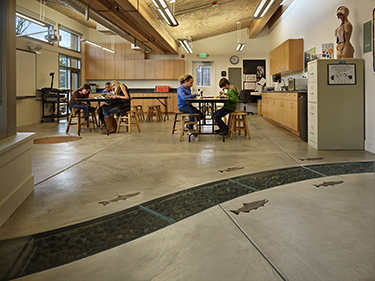|
Subscribe / Renew |
|
|
Contact Us |
|
| ► Subscribe to our Free Weekly Newsletter | |
| home | Welcome, sign in or click here to subscribe. | login |
Construction
| |
 |
May 11, 2018
We’ve got green buildings, how about green communities?
Skanska USA

Smedley
|
Our industry just concluded the 2018 Living Future unConference where a global community of changemakers converged to turn ideas into action. This is the Northwest’s marquee event where we discuss what’s next for sustainability in the design and construction industry.
A veteran of this industry for 15 years, I remember nervously drawing my first stair detail and the excitement as a freshly graduated intern working on a LEED for Homes pilot project, when it was a new certification path.
From that LEED for Homes cottage housing development to the Bertschi School Living Building Challenge project with Skanska, my career opportunities span design and construction of deep green buildings of various scales and types. However, something has nagged at me in this space where buildings and sustainability intersect. How do we shift our approach from designing and constructing deep green buildings to creating entire deep green campuses, communities and cities?
The green building movement historically has largely been just that — a green building movement. At the onset of every green building certification system, progressive code update or system innovation, there is a keen focus on implementation at the single building level, and this does make some sense. There has to be the first adopter, the prototype and the case study to demonstrate that a certain certification or innovation is possible at a building level.
This resulted in an array of what I call “green demonstration projects” internationally — beautiful stand-alone green buildings of various scopes, on campuses and in our cities and communities, that people can tour, experience and learn from. We have examples of this here in Seattle, with projects like the Bullitt Center that is a certified Living Building and a demonstration of several innovative technologies and systems that allow a building to operate at net-zero or positive efficiencies, as well as be constructed of healthy, resilient materials in an urban setting.
With this progress, my troublesome question still exists, and is becoming more nagging as more of these stand-alone built case studies are completed. When do we move from building sustainably, in silos, to building sustainably at the community, campus and city scales where innovations, efficiencies and lessons learned are shared across buildings, owners and project teams?
There are examples of others pushing to forge the path that allows this type of thinking and collaboration. Trends like green rating systems adding campus and community level certification paths are an indication that the design and construction communities are thinking and asking about this. USGBC’s LEED for Neighborhood Development and LEED for Campus and ILFI’s Living Community Challenge allow for larger scale projects with multiple buildings to approach sustainability more holistically and share green choices around site location, shared water and energy efficiencies and healthy material choices.
At Skanska, we are searching for how to apply these things beyond a particular owner or larger project’s boundaries. We can’t just go from individual building silos to larger scale project silos. There should be a way at the jurisdictional and code-making levels to begin to frame what’s possible for communities and cities, so we can allow avenues for knowledge, resource and budget sharing across projects, design and construction teams and owners when a district-scale solution is the most sustainable outcome.
There are instances of owners, cities and communities beginning to explore this. Those of us in the design and construction industries need to support these efforts by advocating for solutions beyond the individual building scale on projects that lend themselves to LEED ND, LEED Campus or the Living Community Challenge. We need to be at the table for discussions looking beyond the site boundaries in our communities and cities, to demonstrate that we are open to collaboration and sharing between us, to achieve the most sustainable outcomes.
A city thinking long-term can observe and forecast the opportunity we’re missing. If we networked our buildings and reused resources amongst them, it will lower overall demand and, ideally, operating costs for building owners and tenants. We can invest in district solutions now to know that we will be able to sustain growth and be more resilient.
I don’t yet have the mind-blowing solutions, but Skanska recognizes it’s time to work with communities to find ways to incentivize and facilitate district-level implementation and take our commitment to green ratings systems such as LEED and Living Building Challenge, and sustainability to the next level.
More of us need to be vocally asking it, not just thinking it to ourselves. That’s how change happens, and there is such an opportunity for us to use our collective knowledge, passion and expertise to make our cities and communities more sustainable. The building-by-building approach isn’t going to cut it in the long run.
Stacy Smedley is director of sustainability at Skanska USA.
Other Stories:
- Eagle of Excellence
Tenant Improvement/Renovation
$4 million-$10 million - Specialty Construction Commercial
less than $5 million - Merit Award Industrial
$5 million-$15 million - Merit Awards Infrastructure
up to $100 million - Merit Award Institutional
less than $5 million - Merit Award Tenant Improvement/Renovation
less than $4 million - Merit Award Tenant Improvement/Renovation
$4 million-$10 million - Survey: Lease Crutcher Lewis
- Survey: Skanska USA
- Survey: Schuchart
- Survey: The Walsh Group
- Survey: Synergy Construction
- Mechanical/Industrial
less than $5 million - Multifamily Construction
$25 million-$100 million - The coming workforce challenge: filling 1M jobs
- Seattle braces for metal tariff fallout
- Here’s how a modular hotel stacks up in Seattle
- Design-build done right: tips for success
- Tight site, deep hole? Bring on the teledipper
- Equipment sector’s heavy lift: regulations, employees
- Pyramid Award
Other Construction
$10 million-$25 million - Commercial Construction
$10 million-$25 million - Commercial Construction
$5 million-$10 million - Commercial Construction
less than $5 million - Healthcare less than $10 million
- Survey: Absher Construction Co.



